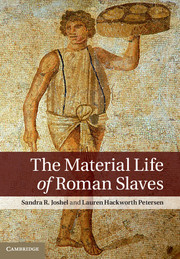Chapter 6 - Conclusion
Published online by Cambridge University Press: 05 November 2014
Summary
. . . 17 October 1905, the skeleton of a slave was discovered, trapped at the place of his death as strong iron shackles bound his legs.
—Notizie degli Scavi 1910, 259, on the villa of the mosaic columns, pompeiiHere lie the bones of Felix, bedchamber servant.
—Corpus of Latin Inscriptions 6.6259, from thecolumbariumof the statilii tauri, romeA skeleton found in 1905 at the Villa of the Mosaic Columns in Pompeii and an epitaph taken from the columbarium of the Statilii Tauri in Rome for a bedchamber servant, Felix, make present two slaves from ancient Italy. The first is visible as a shackled body, and the other as a name and a job. In effect, these actual, historical slaves and their lives are visible in direct ways through their material remains and the marking of them. Some we remember accidently, like the skeleton, a chance discovery of a slave confined in an underground chamber of a villa just outside the walls of Pompeii and left to perish, with no chance of escape as Mt. Vesuvius erupted (Fig. 163). His bound body reminds us of the grim conditions that could characterize Roman slavery, but little is known and knowable about the slave himself – his name, his work, his relationships. His story, the story of the man, takes on fuller shades only when we locate him in a place – in the archaeological record read with the textual sources. The epitaph from the columbarium, or multiburial chamber tomb, gives us something different – written claims that connect the slave’s bones quite literally with a name and job title. Ironically, the epitaph is now separated from the physical remains, since the columbarium is filled in and the epitaph is in a museum, divorced from its niche and place on the wall and hence its relation to other epitaphs. Nonetheless, we remember Felix through the material traces of intentional acts – through Roman rituals of commemoration.
- Type
- Chapter
- Information
- The Material Life of Roman Slaves , pp. 214 - 222Publisher: Cambridge University PressPrint publication year: 2014

